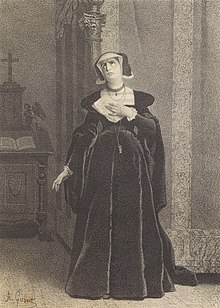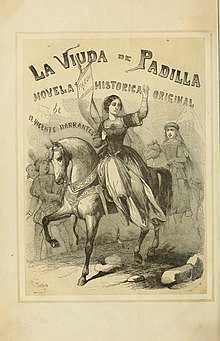Maria Pacheco
María López de Mendoza y Pacheco (The Alhambra, Granada, c. 1496-Porto, March 1531), better known as María Pacheco, was a Castilian noblewoman, community leader and wife of community general Juan de Padilla. After the death of her husband, she assumed command of the uprising of the Communities of Castile from Toledo until she capitulated to King Carlos I of Spain and V of the Holy Roman Empire in February 1522.
Biography
Childhood
Daughter of Íñigo López de Mendoza y Quiñones, 1st Marquis of Mondéjar and 2nd Count of Tendilla, known as the Great Tendilla and of Francisca Pacheco, daughter of Juan Pacheco, 1st Marquis of Villena. She was born in Granada where her father was appointed perpetual mayor of the Alhambra by the Catholic Monarchs, in the palace of Sultan Yusuf III.
He had eight brothers, including Luis Hurtado de Mendoza y Pacheco, II Marquis of Mondejar; Francisco de Mendoza, Bishop of Jaén; Antonio de Mendoza y Pacheco, viceroy in the Indies, and Diego Hurtado de Mendoza, ambassador and poet.
María adopted her mother's last name to differentiate herself from two other sisters, whose last name was Mendoza, with whom she shared the name. The date of her birth is unknown, although there is documentation stating that on the date of her wedding in Granada, with the Toledo hidalgo Juan de Padilla, of lesser lineage than her, on August 18, 1511, she had fifteen years.
Educated along with other of her siblings in the Renaissance environment of the small court of the Great Tendilla, María was a cultured woman, with knowledge of Latin, Greek, mathematics, letters and history, as the humanist Diego Sigeo points out, who accompanied the Portuguese exile:
- It was my lady doña Maria Pacheco very docta in Latin, and in Greek and mathematic, and very read in the Holy Scriptures and in all genres of History, in extreme Poetry. He knew the genealogies of all the kings of Spain and of Africa for fear, and after coming to Portugal on the occasion of his ailment, he passed the most important authors of medicine, so that any lawyer in these faculties that came to talk with him had to come well aperceived, because in all he talked very sotile and ingeniously..
As a child, in 1500, she witnessed the events of the first Moorish uprising from her home in the Albaicín.
Wedding
Fourteen years old. On November 10, 1510, her betrothal was agreed to with Juan de Padilla, a Toledo knight of lower rank than the Mondéjars. In the writings of the time, she appears as Doña María Pacheco, while her husband is treated as Juan de Padilla. In said agreement, she was forced to renounce her paternal inheritance rights in exchange for a dowry of four and a half million maravedis.
In 1511 the marriage took place and in 1516 their only son, Pedro, was born, who died as a child. That year King Ferdinand the Catholic also died and the future Emperor Carlos I was appointed King of Castile and Aragon.
War of the Communities of Castilla
When Juan de Padilla succeeded his father in the position of captain of men-at-arms, the couple moved to Toledo in 1518. María Pacheco supported and perhaps instigated her non-peaceful husband so that, in April 1520, take an active part in the uprising of the Communities in Toledo. Next, Juan de Padilla went with the Toledo militias plus Juan de Zapata's Madrid militias to the aid of Segovia to, together with the militias commanded by Juan Bravo, alderman of Segovia, fight the royalist forces of Rodrigo Ronquillo. On July 29, 1520, the Santa Junta was established in Ávila and Padilla was appointed captain general of the community troops.
However, rivalries between the community members led to his replacement by Pedro Girón and Velasco, before which Padilla returned to Toledo. When Girón defected to the royalist side in December, Padilla returned to Valladolid with a new Toledo army (December 31, 1520). His troops took Ampudia and Torrelobatón. However, once again dissensions arose within the communal army. All this weakened the rebels, who were defeated in an unequal battle on April 23, 1521, known as the Battle of Villalar.
Padilla was taken prisoner. Taken to the town of Villalar, he was beheaded the next day. Juan Bravo and Francisco Maldonado were executed with him.
Resistance in Toledo
In the absence of Padilla, María ruled Toledo until the arrival on March 29, 1521 of the bishop of Zamora Antonio de Acuña, when she was forced to share power with him. Upon receiving the bad news about Villalar, María fell ill and dressed in mourning. However, instead of abandoning her, María Pacheco is going to lead the last resistance of the Communities in Toledo. He directed, from his house first and from the city fortress later, the resistance to the royalist troops, stationing defenders at the city gates and ordering the artillery to be brought from Yepes, implanting contributions and naming captains of the Toledo community troops. After Madrid surrendered on May 7, she only resisted Toledo. Given this, the rest of the community leaders of the city are inclined to capitulate, but she managed to avoid surrender. Even Bishop Acuña fled on May 25 trying to reach France. Part of the rivalry with Acuña was due to her intention to achieve the Toledo miter, primate of Spain, that María wanted for her brother Francisco de Mendoza.
María Pacheco managed to prolong the resistance nine months after the battle of Villalar, although this fact is due, more than to the fierce resistance, to the fact that the royal army had to go to Navarre to neutralize the attempt to recover the Kingdom by part of French and agramontese troops. To maintain order in Toledo, María came to point the cannons of the Alcázar against the Toledans. On October 6, he requisitioned, entering on his knees into the Tabernacle of the Cathedral of Santa María, the money that is contained there to be able to pay the troops.
Meanwhile, the royalist troops, with various battles from April to August, finally surrounded Toledo. On September 1, 1521, the bombardment began. On October 25, 1521, a favorable truce was signed for the besieged, the so-called armistice of the Sisla, so that the community members evacuated the Alcázar, although conserving their weapons and control of the city. This unstable situation culminated on February 3, 1522 with a new uprising in the city, in which María Pacheco and her faithful took over the fortress and freed the imprisoned community members. However, the uprising was put down by royalist troops the next day. Thanks to the collusion of some of her relatives, including her brother-in-law, Gutierre López de Padilla, her sister Maria de Mendoza, Countess consort of Monteagudo de Mendoza, and her uncle, Diego López Pacheco II Marquis of Villena, María Pacheco managed to flee in disguise. from a villager in the city at night with her young son and went into exile in Portugal.
Doña María escaped through a pact, which allowed her to escape with the connivance of one of the guards at the Cambrón gate. With a small entourage that was waiting for her next to the Tagus, she went to Escalona, where her uncle the Marquis of Villena in Escalona refused to host her, although later her uncle Alonso Téllez Girón would take her in at his villa in Puebla de Montalbán until her conviction forced her to flee the kingdom. While on his way to Portugal, hiring different guides daily to get off the main roads and avoid denunciation, the Toledo mayor Zumel sowed salt on the plot of his houses, erecting a column with a sign incriminating María Pacheco and her accomplices. Later, her brother-in-law Gutierre, heir to the estate, would obtain a royal license to rebuild the houses, but he never obtained royal pardon for Doña María or permission to transfer the remains of Juan Padilla to Toledo.
Exile
Excepted in the general pardon of October 1, 1522 and sentenced to death in absentia in 1524, Maria subsists in Portugal with difficulties. Although John III of Portugal does not respond to requests for expulsion from the Castilian court, Maria has no choice but to subsist on charity, first from the Archbishop of Braga, and then from the Bishop of Porto, Pedro Álvarez de Acosta, in whose house she lived.
Despite the attempts of her brothers, Luis Hurtado de Mendoza y Pacheco, II Marquis of Mondéjar and III Count of Tendilla, and Diego Hurtado de Mendoza, ambassador of Carlos I, María Pacheco did not achieve royal pardon and lived in Porto until her death in March 1531. She was buried in the Porto Cathedral, due to Carlos I's refusal to allow her remains to be transferred to Olmedo, to rest alongside those of Juan de Padilla, her husband.
His younger brother, the poet Diego Hurtado de Mendoza, wrote this epitaph:
- If you ask my name, it was Mary; / if my land, Granada; my last name / Pacheco and Mendoza, known / the one and the other more than the clear day; / if my life, follow my husband / my death in the opinion he held. / Spain will tell you my quality, / that never denies Spain the truth.
Juan de Sousa, María Pacheco's chaplain, wrote another epitaph in Latin, whose translation is as follows:
- Mary, of high derivative kings, / of her husband Revenge Padilla, / honor of her sex, lies here buried. / Murdering in proscription, he saw himself private / to go, which he wanted, to the tomb of his husband. / But Sousa and Ficorhous, his servants, / sought him to lie down. / After your body was consumed, / under a slab must be united / the remains of consorts so dear
In popular culture
Due to her heroic adventures, she was known by the townspeople with the nicknames Leona de Castilla, Brava Hembra, Centella de Fuego and The Last Communard.
The life of María Pacheco and her tenacious resistance, following her husband's cause and his ideals, inspired Francisco Villaespesa to write a three-act drama. Based on this drama, Juan de Orduña made a film La Leona de Castilla in 1951 in which Amparo Rivelles played the heroine of Toledo. Despite having been poorly received by critics, the film occupies eighth place on the list of those with the longest run in the decade 1951-1961, with sixty-three consecutive days on the bill.
Before Francisco Villaespesa's work, it had been taken to the theater by Ignacio García Malo and by Francisco Martínez de la Rosa. Recently, a historical novel by Toti Martínez de Lezea is also based on his life.
In the 2015 television series Carlos, King Emperor, María Pacheco was played by Irene Ruiz.
Works
- 1788: Doña María Pacheco, wife of Padilla by Ignacio García Malo
- 1814: The widow of PadillaFrancisco Martínez de la Rosa.
- 1857: The widow of PadillaVincent Barrantes.
- 1913: Doña María Pacheco, also known as the Leone of CastillaFrancisco Villaespesa.
- 1920: La Leona de CastillaJosé Antonio Saldía.
- 1951: La leona de CastillaJohn of Orduña.
- 2003: The Comunera. Maria Pacheco, a rebellious womanToti Martínez de Leza.



